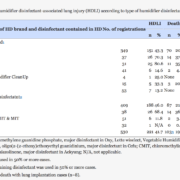Free Article – American Contact Alternatives Group (ACAG) – Miscellaneous
/in Allergic Contact Dermatitis Information/by Sharon Jacob MDPart 4 of a 4-part series Miscellaneous Products:
Scheman A, Jacob S, Katta R, Nedorost S, Warshaw E, Zirwas M, Selbo N.Trends and Alternatives in Deodorants, Antiperspirants, Sunblocks, Shaving Products, Powders, and Wipes: Data from the American Contact Alternatives Group.J Clin Aesthet Dermatol. 2011 Oct;4(10):35-9.
“To provide updated data on the usage of ingredients that are common potential contact allergens in several categories of topical products. To identify useful alternative products with few or no common contact allergens….Percentages of American Contact Dermatitis Society core series allergens (and other common preservatives and sunblocks) were calculated….Data on allergens and alternatives for ancillary skin care products are not widely published. This article reviews some of the common potential allergens in antiperspirants, deodorants, shaving products, sunblocks, powders, and wipes. Suitable available alternative products for patients with contact allergy are listed.”
Free Access to the article here:http://www.ncbi.nlm.nih.gov/pmc/articles/PMC3196302/
Methylisothiazolinone and Fragrance mix sensitization in Iranian Children
/in Uncategorized/by Sharon Jacob MDThe MI and the fragrance mix related chemicals are frequently used in personal hygiene products marketed for children.
Patch testing in Iranian children with allergic contact dermatitis
Hossein Mortazavi, Amirhooshang Ehsani, Seyed Sajed Sajjadi, Nessa Aghazadeh, and Ebrahim Arian
BMC Dermatol. 2016; 16: 10. Published online 2016 Jul 12. PMCID: PMC4943022
“Background”
“Allergic contact dermatitis is a common disorder in adults and children alike and appears to be on the increase. The purpose of this study was to determine the sensitization trends in Iranian children with contact dermatitis.“
“For most allergens (except cobalt chloride, methylisothiazolinone, paraben mix, and fragrance mix), the percentages of positive response in the older age group (11–18 years) were higher than children below 10 years. The most common allergen in the younger age group were cobalt chloride (4, 18.2 %), nickel sulfate (3, 13.6 %), methylisothiazolinone (2, 9.1 %), and paraben mix (2, 9.1 %) while in the older group they were as follows: nickel sulfate, cobalt chloride, methylisothiazolinone, colophony, potassium dichromate.“
Read more here:http://www.ncbi.nlm.nih.gov/pmc/articles/PMC4943022/
lung injury and humidifier disinfectant – MI! Free article
/in Uncategorized/by Sharon Jacob MDMajor concerns regarding lung injury and related health conditions caused by the use of humidifier disinfectant.
Abstract
A total of 221 patients were evaluated to be humidifier disinfectant associated with lung injury (HDLI) through two rounds of programs through April 2015. The humidifier disinfectant (HD) brands most often associated with HDLI were found to be Oxy (n=151, 68 %) and Cefu (n=26, 17 %). Polyhexamethylene guanidine used for disinfectant for four types of HD brands including Oxy was found to be associated with the highest number of HDLI cases (n=188). Further programs are operating to identify various health effects including lung injury which may be associated with the use of HD. Not only national agencies, but also pertinent environmental health societies should cooperate in the necessary investigations so that this tragedy can be properly addressed and future incidents concerning chemicals and chemical-containing products can be prevented.
KEYWORDS:
Chloromethylisothiazolinone; Methylisothiazolinone; Oligo(2-)ethoxyethoxyethyl guanidine chloride; Polyhexamethylene guanidine; humidifier disinfectant; lung injury
Read more here: http://e-eht.org/journal/view.php?doi=10.5620/eht.e2016014
Introduction:
“Korean authorities recently completed two rounds of programs (first: July 2013 through April 2014; second: July 2014 and April 2015) in an effort to examine the association of humidifier disinfectant-associated lung injury (HDLI) with the use of humidifier disinfectant (HD) by collecting information on individuals with lung injury who presumed their condition to be related to the use of HD and determining whether these registered cases were indeed associated with the use of HD. A total of 221 were evaluated as being associated with use of HD, including interstitial pneumonitis and widespread lung fibrosis, necessitating lung transplantation for some.” … “In 2012, two HDLI patients aged one year who were exposed to the Aekyung brand of HD containing a mixture of CMIT and MIT that had been exempted from the recall list were evaluated to be HDLI victims.”
Table 1 discusses the Distribution of humidifier disinfectant-associated lung injury (HDLI) according to type of humidifier disinfectant (HD) and disinfectant… 51 registrants used 6 had HDLI. 2 died.
Conclusion:
“The tragedy caused by household use of HD products cannot be resolved within a short period of time. It will require considerable time and effort to identify the victims, compensate them for damages, delineate the exact causes and take appropriate measures to prevent any recurrence of incidents caused by household products. Not only national agencies, but also pertinent environmental health societies should cooperate in the necessary investigations so that this tragedy can be properly addressed and future incidents concerning chemicals and chemical-containing products can be prevented.”
Food Nickel Content Quiz
/in Allergic Contact Dermatitis Facts, Allergic Contact Dermatitis Information/by Sharon Jacob MDInformative quiz to test your knowledge of nickel content in popular foods.



